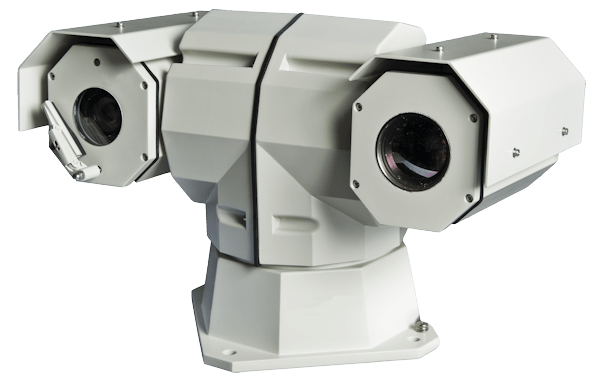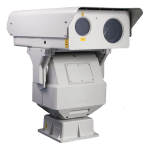Long-Range IR PTZ System
Long-Range Optical Cameras | Thermal Cameras | Multi-sensor Cameras
There are several types of long-range PTZ camera systems. Long-range cameras can see over one mile away during the day or night. Some can even see through the fog.
Long-Range Cameras for Day and Night Applications
Many long-range optical PTZ cameras can see things that are miles away. Some are available off-the-shelf. The IR illumination provides up to 1,600 ft (500m) of visibility at night. Read more …
Thermal Imaging PTZ Cameras
The thermal imaging cameras use special sensors and lenses to view objects in total darkness. These cameras include special lenses that allow infra-red light to reach the sensor. Read more …
Custom-Made Long-range PTZ cameras
The customized long-range camera systems provide extreme range capability. The PTZ camera systems are available with optical or thermal imaging cameras, or both in one system. Read more …
Drone Detection and Elimination
Long-Range camera systems enhanced with Drone detection and elimination equipment. Read more
Overview of Custom Long-Range Camera Systems
The long-range IP camera systems provide night-vision using either a long-range laser illuminator or an additional thermal camera. We build the long-range surveillance camera system exactly to your requirements. These IP camera systems include a very long-distance lens and special pan-tilt mechanisms that allow you to see details that are over 2 miles away. It attaches to your network and can be integrated into a complete security system. There are some off-the-shelf camera systems available as well.
FEATURES:
- See faces, read license plates, numbers and words in complete darkness
- Utilizes image sensors that optimize day and night viewing
- High-resolution HD camera system (up to 2 Megapixels)
- Select models with a choice of optical cameras, thermal cameras, and focused laser illumination
- This long-range surveillance system connects to the network or uses the analog video interface
- Optional wireless connectivity
- Select PTZ cameras with over 62X optical zoom
- Select cameras with motion image stabilization
- Operates in all weather environments: NEMA IP66 Rating to prevent the ingress of water and minute particles
- Can be used in a wide range of temperatures: -40° F to 131° F (-40° C to + 55° C)
Know your objectives before selecting the long-range IP camera system
Do you want to detect something in the distance? Do you want to recognize if it’s a truck or car? Or, do you want to be able to identify a person’s face or a license plate? Take a look at our definitions below and read our article, How far can we see with PTZ IR camera. Do you plan to mount the camera on a ship or vehicle that requires a camera system with motion stabilization? Read about camera stabilization in our article, IP Camera Motion Stabilization.
Here’s a short video that shows the capability of these extremely long-range cameras:
The chart below provides examples of custom-made long-range cameras that can be used day or night. The ranges are provided for human targets. We can see vehicles or ships further away, and of course, the size of the object will determine the distance. Note that anything that’s over about 3 miles away is beyond the curvature of the earth and at extreme distances atmospheric conditions will determine actual visibility. For more information about real-world range calculations, take a look at our article, “Detection, Recognition, Identification: The New Criteria“.
Product Specifications (Example Systems)
Common Specifications
Camera: High Resolution 2 Megapixel, 1080P, HD ONVIF Day Night IP IR Camera
Weather Resistance: IP66
Operational temperature: -40 C° to 60 C°
Pan Tilt Zoom (PTZ): 360 Degree Pan Tilt Driver with Micro Step
Image Stabilization: Image stabilization provides clear video even when the camera is shaking. Many of these models are available with optional image stabilization
IR Illuminator: Auto-range adjusted Laser system
Warning Note: Lasers with over 15-Watt power levels can exceed the danger limit for human eyes at close range. This is called the Nominal Ocular Hazard Distance (NOHD). The risk of eye damage can be reduced by preventing people from being too close to the illuminator. An active range finder system can be added to the camera system that automatically turns off the illuminator whenever an object is closer than this minimum range.
Custom Designed Long-Range IP Camera Systems
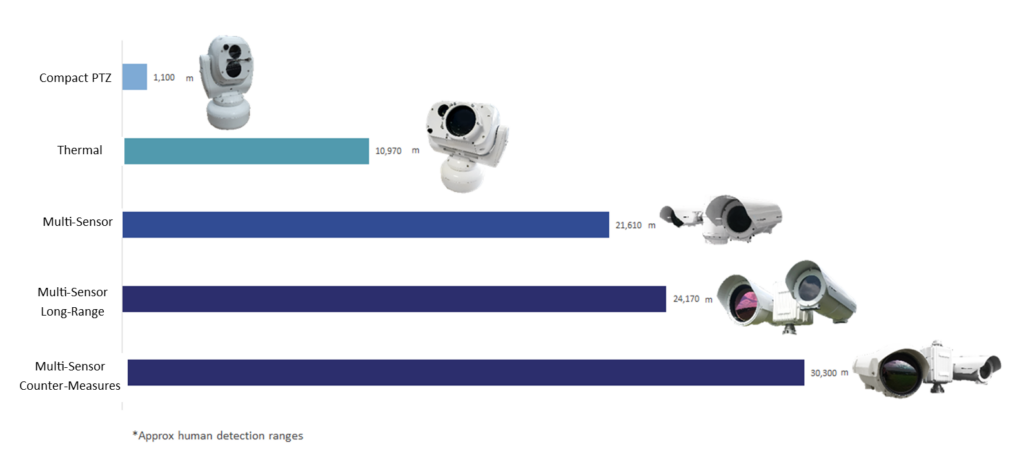
These high-performance PTZ systems include not only a very long-range optical camera system but also a thermal imaging camera for operation in total darkness.
The long-range camera system platform is an AI-driven operating environment that provides integration of other off-the-shelf platforms and payloads into one centralized system. The highly accurate pan-tilt platform allows users to exchange, upgrade, and add hardware. All added platforms can be centrally managed and, more importantly, continually updated and upgraded with the latest surveillance and threat detection software improvements, offering a sustainable and cost-effective solution without in-factory involvement.
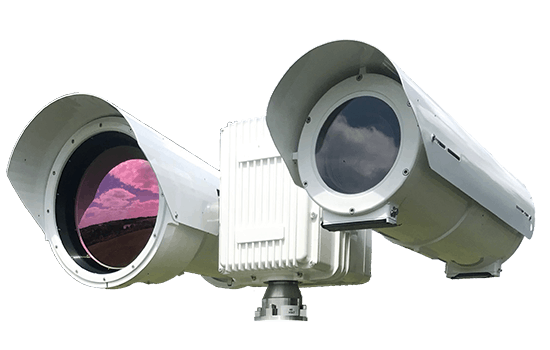
Drone Detection and Elimination
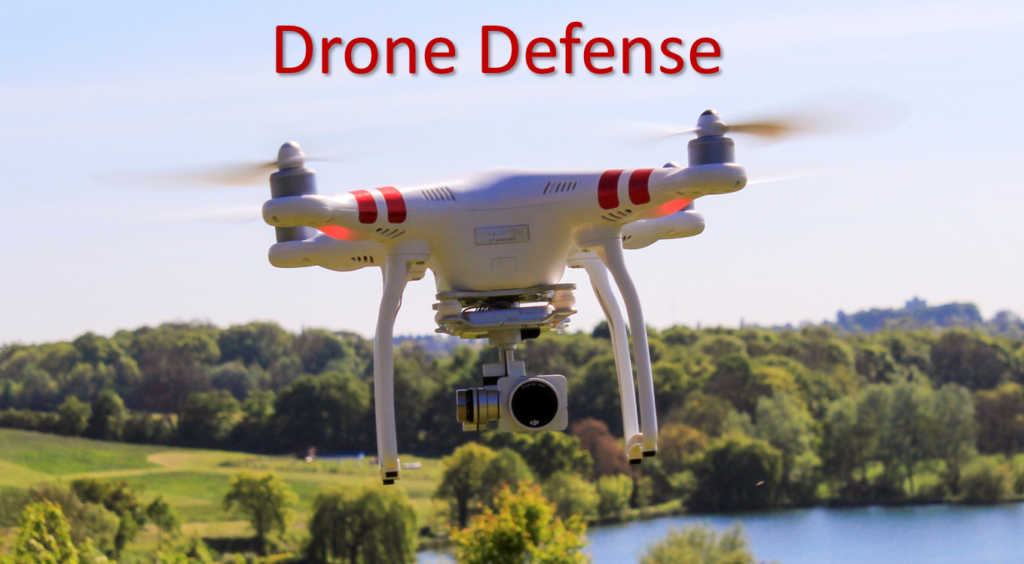
Long-Range camera systems can be enhanced with Drone detection and elimination equipment.
The need for precise and reliable detection and identification of unmanned aerial vehicles (UAVs) has become paramount for government agencies, law enforcement, and military organizations worldwide. Kintronics provides advanced and highly modular surveillance camera platforms for land and maritime applications, offering an effective solution for counter-drone operations. To learn more read our article Long-Range PTZ Cameras With Drone Deterrents.
Need more details or pricing? Give us a call at 1-800-431-165 or 914-944-3425 or contact. We can design the long-range IP camera system that exactly meets your requirements.
Resources:
- Technical Notes To help you understand the technology.
- Thermal versus Optical IP Cameras explains the difference between these surveillance camera systems and describes the when each technology should be used.
- Seeing in the Dark describes the technology available to see better than an owl.
- How Far Can We See With the PTZ IP Camera provides the details about how we calculate the ranges for the cameras based on the criteria of detection, recognition, and identification.
- Comparison of Long Range Cameras reviews the components that make up a long-range camera system and shows how total system performance determines the price.
- IP camera Motion Stabilization compares the different image stabilization techniques available and how they work.
To learn more about how long-range cameras work, take a look at our video that shows how various PTZ long range IP camera systems actually perform,
Contact us for help selecting the right cameras, lenses, enclosures, NVR software and more.
Comparison of IR Illumination to Thermal Imaging:
Both types of cameras allow you to see in the dark, but the Thermal Imaging cameras utilize the heat energy radiating from the object viewed, while the Infrared or IR cameras utilize an IR illuminator.
The Thermal Imaging system can detect an object further away, and operate through fog and dust, but the Optical IR camera system provides much better resolution and grayscale making it possible to identify a person’s face or license plate number.
The Optical IR PTZ system utilizes a unique fully zoom-able Continuous Wave Laser Illumination system. This patent-pending capability makes it much easier to focus on a remote target.
To learn more about when to use a thermal camera or an optical camera, take a look at our article, Thermal versus Optical IP Cameras.
Definitions Used in Thermal Imaging versus Optical IR night vision Systems
The Johnson Criteria uses line pairs for all these definitions. The criteria also say that the probability of detection by the observer is about is 50%. A line pair is equal to 4 to 5 pixels.
Detection
Thermal imaging cameras typically use the Johnson Criteria to determine its’ “detection” capability. The Johnson Criteria, used by thermal imaging manufacturers, indicates that 1.5 vertical line pairs ( 5 to 7 pixels) are needed to provide “detection”.
Optical systems usually state that they need at least 10 pixels for detection.
Recognition
In the thermal imaging parlance, recognition is defined by whether an object can be discerned. For instance, is the target a tank, building, person, etc. Thermal Imaging cameras indicate that somewhere between 4 to 5 line pairs (about 10 to 15 pixels) are needed to make this determination.
In the optical camera world, especially at the longest range of optics, we need more pixels for recognition. The specifications for the optical systems use a much more conservative >30 pixels for recognition.
Identification
There is some confusion about this category. Most Thermal Imaging companies do not even discuss these criteria, as it is difficult to hit this performance level at distance ranges. In thermal imaging parlance, this is defined as a specific object being discerned, such as the object is friend or foe, or that the object is a T-72 tank or M1-Abrams. The thermal Imaging guide indicates that only about 6.4 line pairs (14 to 18 pixels) are required.
In the optical world, “identification” means that you can identify a person’s face or license plate number. We define this as at least 50 – 80 pixels across the target object for the IP camera system.
To learn more about what you can see with a thermal or optical camera, take a look at our article, Detection, Recognition, Identification – Thermal vs. Optical Camera. We also suggested an alternative to the Johnson Criteria that provides more predictable results. Take a look at the article, Detection, Recognition, Identification: The New Criteria.
If you need more help defining your system, please contact us at 1-800-431-1658 in the USA, or at 914-944-3425 everywhere else, or use our contact form.
